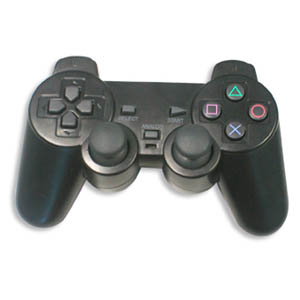Photorealism is not the limiting factor in creating new genres of games. And I’m actually kind of surprised anyone believed that it was.
Honestly, we’ve had “photorealistic” games for a long time. They were really popular in the ’90’s, for example, when CD-ROM games used live actors and full motion video to create a feeling of “realism.” Those of us not too young to remember this era, might remember this being hailed as the next revolution in photorealistic, very serious film-like games. This didn’t pan out. Mostly, for two basic reasons:
1. Actors phoning it in made the whole process silly.
2. The actual limitation, the actual problem, which is this:
this,
or even this,
or, frequently this,
And many other examples. That is, the fact that we’re limited in our ability to ability to actually interact with games in a lot of meaningful ways, because we must use a physical interface.
There is still a fantasy about “the holodeck,” the totally immersive, all-encompassing game experience. Step in to the holodeck, and a game begins that encloses the player fully, blurring the line between game and reality. Yes, this fantasy is interesting because the player is surrounded with and immersed by it. But more importantly, it’s interesting because it’s truly, fully interactive: a simulation where a player may speak to people, and those people respond in kind. The input interface for the holodeck is intuitively understood.
I’m a big fan of works of Interactive Fiction, sometimes called text adventures. IF is a game genre all on its own. Yet it is an excellent way of exploring game genres frequently unexplored: personal drama, big narrative, romance. However, in most IF works, commands must be typed into a text parser to interact with the game. That means the barrier to entry for a new player can be high: too high.
Games like Heavy Rain can tell interesting interactive stories to novice players, but Heavy Rain has to do it using a controller, a setup that invites comparisons to games like Dragon’s Lair of ages past. Would Heavy Rain be a different game if it were photorealistic? Not particularly. Would it be a different game, maybe a different genre, without the controller? Of course.
Don’t misunderstand… I like the controller. Controllers, dance pads, guitars, keyboard and mouse, touchscreen… all game input devices are just as much about the game as the software they inform. The new interface, in its way, creates the game. The Wii controller invited “Wii games,” did best with games suited for its unique handling, and didn’t seem quite right for lots of games that would’ve been comfortable with the more standard controller setup. Input, in a sense, makes the videogame.
If we want to create new genres, we need new ways to interact with those genres. That means new input devices. Devices that, for example, allow the player to speak to the game, and be actually heard (along with software that drives the recognition of that speech). Or devices that allow the full range of motion capable of our bodies or even our hands.
Kinect is an interesting first step in this direction. Proving the point, however, Kinect works best with games that are suited exactly for it. Dance Central, for example, works well because it’s specifically designed to track the player’s body in a mostly-stationary position, working both with the strengths and limitations of Kinect. Kinect works poorly when used to try to replicate traditional videogame experiences that are already perfectly optimized for the controller. It becomes a gimmick, then, rather than a useful device.
But, because of Kinect, there are Kinect games. Because of the Wii, there are Wii games. Guitar Hero is what it is (or, was what it was) because of the guitar. The best touchscreen games find an intuitive way to use the touchscreen; games that try to replicate the controller experience with the touchscreen can only do it half-well at best.
I think one of the primary limitations that can hold back a game is trying to choose the wrong game type for the input device. I also believe that the more input devices we have to choose from, the more different genres games can explore. There are genres possible that we haven’t conceptualized yet, because we haven’t invented the way to interact with them properly. Those game genres may someday even be photorealistic… or not.
Written for: Blogs of the Round Table
Images Via a quick-and-dirty Google Image Search.





Leave a Reply